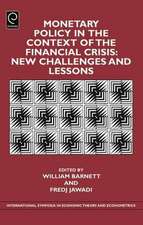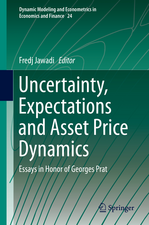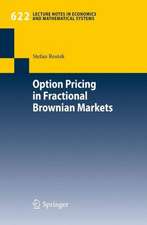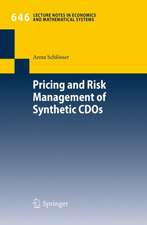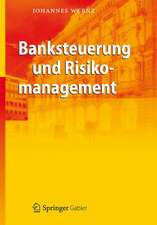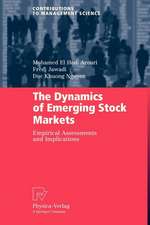Market Microstructure and Nonlinear Dynamics: Keeping Financial Crisis in Context
Editat de Gilles Dufrénot, Fredj Jawadi, Waël Louhichien Limba Engleză Paperback – 3 sep 2016
| Toate formatele și edițiile | Preț | Express |
|---|---|---|
| Paperback (1) | 641.85 lei 6-8 săpt. | |
| Springer International Publishing – 3 sep 2016 | 641.85 lei 6-8 săpt. | |
| Hardback (1) | 788.72 lei 6-8 săpt. | |
| Springer International Publishing – 29 iul 2014 | 788.72 lei 6-8 săpt. |
Preț: 641.85 lei
Preț vechi: 755.13 lei
-15% Nou
Puncte Express: 963
Preț estimativ în valută:
122.81€ • 128.24$ • 101.42£
122.81€ • 128.24$ • 101.42£
Carte tipărită la comandă
Livrare economică 15-29 aprilie
Preluare comenzi: 021 569.72.76
Specificații
ISBN-13: 9783319343259
ISBN-10: 3319343254
Pagini: 327
Ilustrații: XII, 315 p. 32 illus.
Dimensiuni: 155 x 235 x 18 mm
Greutate: 0.46 kg
Ediția:Softcover reprint of the original 1st ed. 2014
Editura: Springer International Publishing
Colecția Springer
Locul publicării:Cham, Switzerland
ISBN-10: 3319343254
Pagini: 327
Ilustrații: XII, 315 p. 32 illus.
Dimensiuni: 155 x 235 x 18 mm
Greutate: 0.46 kg
Ediția:Softcover reprint of the original 1st ed. 2014
Editura: Springer International Publishing
Colecția Springer
Locul publicării:Cham, Switzerland
Cuprins
Market Fragmentation and Market Quality: The European Experience.- Pre-trade Transparency and the Information Content of the Limit Order Book.- Trading Mechanisms in Financial Markets: A Comparison Between Auction and Dealership Markets.- News Trader, Liquidity and Transaction Cost.- What Moves Euro-Bund Futures Contracts on Eurex? Surprises!- Individual Investors' Trading Activities and Price Volatility.- Finance and Growth Causality: Empirical Evidence for Emerging Europe.- Anticipated Macroeconomic Fundamentals, Sovereign Spreads and Regime-Switching: The Case of the Euro Area.- Impact of Anti-crisis Measures on the Volatility of the Stock Market Stress Index in the Euro Zone (Application of ARCH/GARCH/EGARCH).- Shift-Volatility Transmission in East Asian Equity Markets: New Indicators.- Transaction Costs and Nonlinear Modelling of Real Exchange Rate Deviations from Purchasing Power Parity: Evidence from the MENA Region.
Notă biografică
Gilles Dufrénot is currently Professor of Economics at the Aix-Marseille University. He worked as a consultant for International Organizations, central banks and governments in the fields of policymaking (IMF, European Commission WAEMU Commission, African Development Bank). His areas of specialization include time series econometrics, fiscal and monetary policies, international finance. He has published many papers in international refereed journal and has published books. His recently published book (After the crisis: the economic policies in the world, Economica, Paris, in French) has been rewarded a special mention of the Turgot Prize of the best book in Financial Economics). He is currently the director of the Department "Economic development and International finance" of the GREQAM, a research center specialized in quantitative and mathematical economics.
Fredj Jawadi is an Associate Professor of Economics at the University of Evry Val d' Essonne in France. His research focuses on financial economics and nonlinear Time Series Econometrics. He has written and edited several books in Economics and Finance and authored several papers published in international journals.
Waël Louhichi is currently a Professor of Finance at ESSCA School of Management. He was previously an Associate Professor of Finance at Rennes 1 University and Assistant Professor at Amiens School of Management. He obtained a Ph.D from both Perpignan University (France) and Louvain School of Management (Belgium). His main area of research is market microstructure & financial accounting and has published several articles in international journals (Review of Accounting and Finance, Management Decision, Journal of Asset Management, Journal of Applied Business Research, International Review of Financial Analysis, Applied Financial Economics, Applied Economic Letters, International Economics, Applied Economics, etc.).
Fredj Jawadi is an Associate Professor of Economics at the University of Evry Val d' Essonne in France. His research focuses on financial economics and nonlinear Time Series Econometrics. He has written and edited several books in Economics and Finance and authored several papers published in international journals.
Waël Louhichi is currently a Professor of Finance at ESSCA School of Management. He was previously an Associate Professor of Finance at Rennes 1 University and Assistant Professor at Amiens School of Management. He obtained a Ph.D from both Perpignan University (France) and Louvain School of Management (Belgium). His main area of research is market microstructure & financial accounting and has published several articles in international journals (Review of Accounting and Finance, Management Decision, Journal of Asset Management, Journal of Applied Business Research, International Review of Financial Analysis, Applied Financial Economics, Applied Economic Letters, International Economics, Applied Economics, etc.).
Textul de pe ultima copertă
This book discusses market microstructure environment within the context of the global financial crisis and investigates the recent econometric tools toimprove financial markets dynamics in calm and turbulent times. In the first part, the market microstructure theory is examined and the main microstructure models and hypotheses are discussed. In particular, contributors focus on themain effects of the financial downturn through an examination of marketmicrostructure dynamics, the limitations associated with standard microstructure models and the investigation of ways to improve such models.
Interestingly, promising analyses based on recent high-frequency data and sophisticated models discuss new regulations, and recent developments for financial markets are provided in order to improve the understating of market microstructure evolution. As for the second part, this book focuses on Nonlinear Dynamics. Through interesting contributions concerning stock markets, exchange rate and bond markets, authors propose several new specifications to improve the modelling of key financial variables such as return, risk premium, risk, etc. Also, this part provides interesting explanations of the effects and the consequences of high-level linkages between financial markets. Finally, while analyzing the effect of the recent global financial crisis and the reaction function of investors, markets and institutions, authors specify the appropriate way to better forecast financial markets dynamics and improve investment and financial decisions. For both parts, well-known experts on market microstructure and nonlinear econometrics contribute to the chapters in the book.
This book is strongly recommended for academic researchers, students and quantitative practitioners.
Interestingly, promising analyses based on recent high-frequency data and sophisticated models discuss new regulations, and recent developments for financial markets are provided in order to improve the understating of market microstructure evolution. As for the second part, this book focuses on Nonlinear Dynamics. Through interesting contributions concerning stock markets, exchange rate and bond markets, authors propose several new specifications to improve the modelling of key financial variables such as return, risk premium, risk, etc. Also, this part provides interesting explanations of the effects and the consequences of high-level linkages between financial markets. Finally, while analyzing the effect of the recent global financial crisis and the reaction function of investors, markets and institutions, authors specify the appropriate way to better forecast financial markets dynamics and improve investment and financial decisions. For both parts, well-known experts on market microstructure and nonlinear econometrics contribute to the chapters in the book.
This book is strongly recommended for academic researchers, students and quantitative practitioners.
Caracteristici
Examines the market microstructure dynamics to understand effects of financial downturn Provides information and analysis of new financial regulations Helps to define optimal investment strategies A definitive volume with contributions from leading experts on market microstructure










